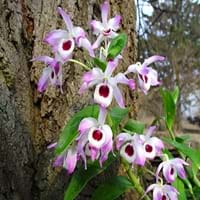Life Span
Perennial
Perennial
Origin
Southeastern United States, North-Central United States, Central United States, South-Central United States, Southwestern United States, Texas, Canada, Mexico
Eastern Asia, Southern Asia, Southeastern Asia, India, Nepal, China
Types
Not Available
Not available
Number of Varieties
Not Available
Habitat
Dry areas, Prairies, Rocky areas, rocky outcrops
Deciduous forests, Woodlands
USDA Hardiness Zone
3-10
11-12
Sunset Zone
A1, A2, A3, H1, H2, 1a, 1b, 2a, 2b, 3a, 3b, 4, 5, 6, 7, 8, 9, 10, 11, 12, 13, 14, 15, 16, 17, 18, 19, 20, 21, 22, 23, 24
24
Habit
Upright/Erect
Clump-Forming
Flower Color
Yellow, Purple, Burgundy, Light Green, Brown
White, Purple, Pink, Burgundy, Dark Red, Ivory
Flower Color Modifier
Bicolor
Multi-Color
Fruit Color
Brown
Non Fruiting Plant
Leaf Color in Spring
Light Green, Gray Green
Green
Leaf Color in Summer
Light Green, Gray Green
Green
Leaf Color in Fall
Light Green, Gray Green
Green
Leaf Color in Winter
Light Green
Not Available
Leaf Shape
Subulate
Lance shaped
Plant Season
Summer
Spring, Summer, Fall, Winter
Sunlight
Full Sun
Partial Sun, Partial shade
Type of Soil
Loam, Sand
Not Available
The pH of Soil
Neutral
Acidic, Neutral
Soil Drainage
Well drained
Well drained
Bloom Time
Late Spring, Early Summer, Summer, Late Summer
Early Spring, Spring, Late Winter, Indeterminate
Tolerances
Drought
Cold climate, Not Available
Where to Plant?
Ground
Container, Ground, Pot
How to Plant?
Seedlings
Cuttings, From bulbs, Rhizome division
Plant Maintenance
Medium
Medium
Watering Requirements
Average Water Needs, Water in morning to avoid prompting diseases
Do Not over Water, Keep ground moist, Requires watering in the growing season
In Summer
Lots of watering
Lots of watering
In Spring
Moderate
Moderate
In Winter
Average Water
Average Water
Soil pH
Neutral
Acidic, Neutral
Soil Type
Loam, Sand
Not Available
Soil Drainage Capacity
Well drained
Well drained
Sun Exposure
Full Sun
Partial Sun, Partial shade
Pruning
Cut or pinch the stems, Pinch Tips, Remove damaged leaves, Remove dead branches, Remove dead flowers, Remove dead leaves, Remove dead or diseased plant parts, Remove deadheads
Cut leaves after fall, Prune in flowering season
Fertilizers
All-Purpose Liquid Fertilizer, Apply N-P-K
Fertilize in early to mid-summer, Fertilzer with low nitrogen content
Pests and Diseases
Pests and diseases free, Red blotch
Red spider mite, Watery soft rot
Plant Tolerance
Drought, Dry Conditions, Dry soil, Full Sun
Cold climate
Flower Petal Number
Single
Single
Foliage Texture
Fine
Medium
Foliage Sheen
Matte
Matte
Attracts
Birds, Butterflies
Not Available
Allergy
Rhinitis
convulsions, Dermatitis, Toxic
Aesthetic Uses
Borders
Beautification, Decorating walls, Hanging Basket, Used as an interior landscaping species, Used for decorating walls, fences, gates, hedges, etc.
Beauty Benefits
Not Available
Glowing Skin, Perfumes, Provides herbal hair care, Skin cleanser
Environmental Uses
Air purification
Food for animals, Food for birds
Medicinal Uses
Analgesic
Analgesic, Antipyretic, Diabetes, Digestion problems, Eye Problems, Gallbladder Diseases, Liver Protection
Part of Plant Used
Flowers
Whole plant
Other Uses
Can be made into a herbal tea, Used in making tea
For making oil for cosmetics, Use in Chinese herbology, Used as Ornamental plant
Used As Indoor Plant
No
Yes
Used As Outdoor Plant
Yes
Yes
Garden Design
Container, Cutflower, Mixed Border, Wildflower
Container, Hanging Basket, Houseplant, Rock Garden / Wall, Tropical
Botanical Name
RATIBIDA columnifera
DENDROBIUM nobile
Common Name
Mexican Hat
Dendrobium, Noble Dendrobium, Sentinel Orchid
In Hindi
Mexican Hat
Noble Dendrobium
In German
Mexican Hat
Noble Dendrobium
In French
Mexican Hat
Dendrobium nobile
In Spanish
mexican Hat
Dendrobium nobile
In Greek
Mexican Hat
Dendrobium nobile
In Portuguese
Mexican Hat
Nobile Dendrobium
In Polish
Mexican Hat
Dendrobium szlachetne
In Latin
Mexicanus Hat
Nobile Dendrobium
Phylum
Tracheophyta
Tracheophyta
Class
Magnoliopsida
Equisetopsida
Order
Asterales
Asparagales
Family
Asteraceae
Orchidaceae
Genus
Ratibida
Dendrobium
Clade
Angiosperms, Asterids, Eudicots
Angiosperms, Monocots
Tribe
Not Available
Dendrobieae
Subfamily
Not Available
Epidendroideae
Number of Species
Not Available
Season and Care of Mexican Hat and Nobile Dendrobium
Season and care of Mexican Hat and Nobile Dendrobium is important to know. While considering everything about Mexican Hat and Nobile Dendrobium Care, growing season is an essential factor. Mexican Hat season is Summer and Nobile Dendrobium season is Summer. The type of soil for Mexican Hat is Loam, Sand and for Nobile Dendrobium is Not Available while the PH of soil for Mexican Hat is Neutral and for Nobile Dendrobium is Acidic, Neutral.
Mexican Hat and Nobile Dendrobium Physical Information
Mexican Hat and Nobile Dendrobium physical information is very important for comparison. Mexican Hat height is 30.00 cm and width 30.50 cm whereas Nobile Dendrobium height is 25.40 cm and width 15.20 cm. The color specification of Mexican Hat and Nobile Dendrobium are as follows:
Mexican Hat flower color: Yellow, Purple, Burgundy, Light Green and Brown
Mexican Hat leaf color: Light Green and Gray Green
Nobile Dendrobium flower color: White, Purple, Pink, Burgundy, Dark Red and Ivory
- Nobile Dendrobium leaf color: Green
Care of Mexican Hat and Nobile Dendrobium
Care of Mexican Hat and Nobile Dendrobium include pruning, fertilizers, watering etc. Mexican Hat pruning is done Cut or pinch the stems, Pinch Tips, Remove damaged leaves, Remove dead branches, Remove dead flowers, Remove dead leaves, Remove dead or diseased plant parts and Remove deadheads and Nobile Dendrobium pruning is done Cut leaves after fall and Prune in flowering season. In summer Mexican Hat needs Lots of watering and in winter, it needs Average Water. Whereas, in summer Nobile Dendrobium needs Lots of watering and in winter, it needs Average Water.





